SI Swimsuit 2022 Destinations: Belize
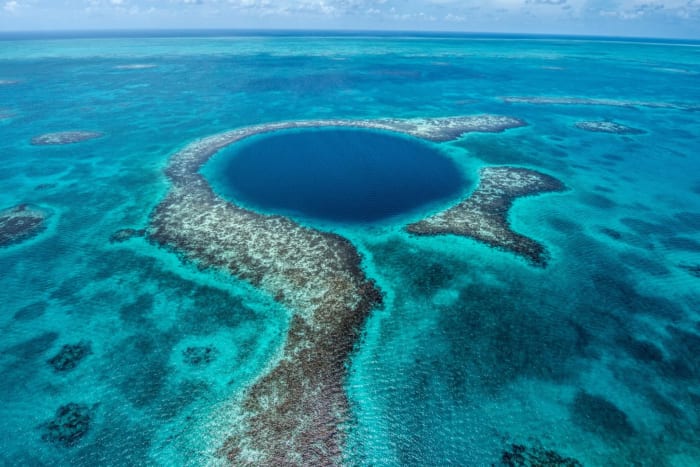
Belize is home to the world's second-largest barrier reef, which includes the famous Great Blue Hole.
SI SWIMSUIT 2022 DESTINATIONS: BELIZE | BARBADOS | DOMINICAN REPUBLIC | MONTENEGRO | USVI ST. THOMAS | USVI ST. CROIX
Belize is a remarkable paradise full of beaches, toucans, and some of the best scuba and snorkeling in the world! Between jungles, lagoons and desolate islands with stunning waters, agriculture and wildlife, you will have plenty to explore on your trip to Belize. The 2022 Swimsuit Issue featured models Kate Bock, Hunter McGrady, Jasmine Sanders, Leyna Bloom and Natalie Mariduena, all photographed in Belize.
In Belize, traditions and customs are varied and represent more than eight diverse cultures. Belizeans are proudly committed to preserving the country’s unique charms and pristine natural landscape. Beyond the natural wonders, archaeological marvels and adrenaline-inducing adventures, it is truly the warmth of the Belizean people that makes Belize so special. The blending of cultures in Belize has resulted in one of the happiest and most peaceful countries in the region, and has garnered a widespread reputation as one of the world’s friendliest destinations.
On our trip to Belize, the SI team stayed at The Rainforest Lodge at Sleeping Giant and Naia Resort and Spa. Sleeping Giant offers incredible opportunities to indulge in authentic local cuisine, explore their 600-acre property (featuring on-site adventurous activities), relax in one of their 31 award-winning accommodations and is conveniently located to other main attractions. The Naia Resort and Spa is an excellent choice when prioritizing your health/wellness. They offer access to their spa, yoga classes, exceptional accommodations and adventure tours. You really can’t go wrong with any of them!
Click here for a guide to 18 places not to miss on your trip to Belize!
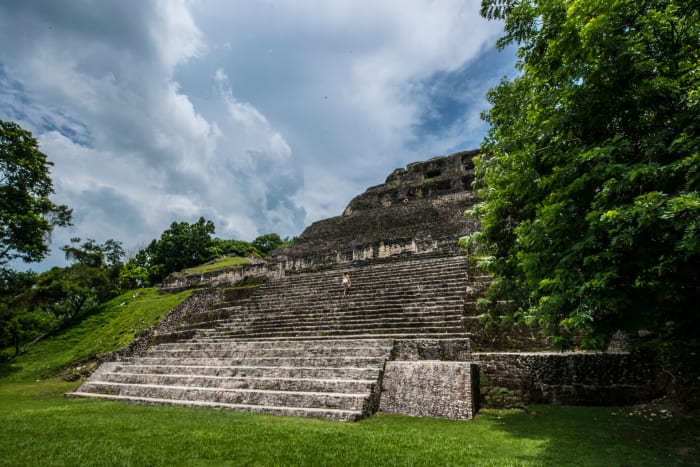
In 2500 B.C. the Maya in Belize inhabited the area now known as Cuello, one of the oldest Maya archeological sites in the region.
FAQ
Where is Belize?
Belize is in Central America, bordered to the north by Mexico, to the south and west by Guatemala, and the Caribbean Sea along the east.
How do I get to Belize?
From the U.S., direct nonstop flights to Belize are available through Alaska Airlines, United Airlines, American Airlines and Delta Airlines, with direct nonstop seasonal (November to April) flights to Belize available with Sun Country Airlines, Southwest Airlines and Frontier Airlines. From Canada, direct nonstop seasonal (November to April) flights to Belize are available with WestJet from Toronto, with Calgary routes anticipated to return.
To fly within Belize, Tropic Air and Maya Island Air operate regular service throughout the county. Tropic Air also has daily flights from Cancun to Belize International that offer connecting opportunities.
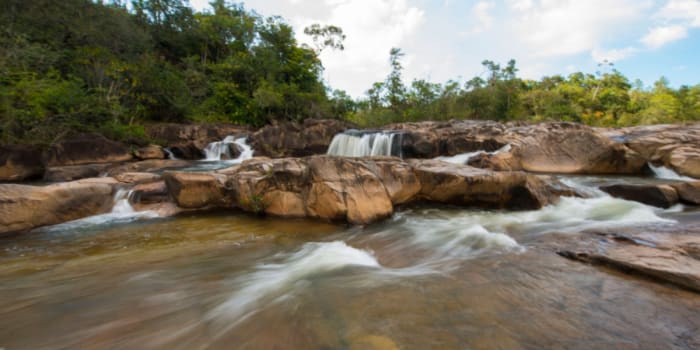
Mountain Pine Ridge, Rio On Pools
Any interesting historical notes about Belize?
Belize is home to the first civilization, the Maya, and there are three groups of Maya still living in the country today, making Belize a destination where visitors cannot only learn about the magnificent indigenous culture but can also engage with the culture firsthand.
Today, Maya make up approximately 11% of Belize’s population, and generally the Maya live in sprawling villages (some remain close to sites of the earliest Maya settlements, such as Altun Ha, Xunantunich, Lamanai Cuello, and Lubaantun. These archaeological Maya sites can be visited today and stand as reminders of the remarkable history of the first people.
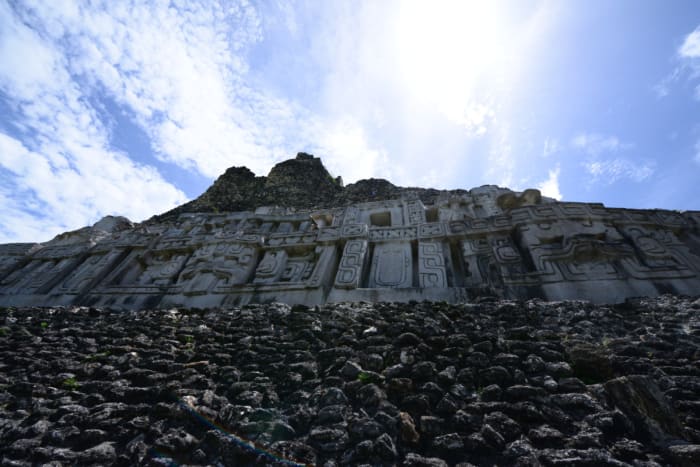
Belize is home to the first civilization, the Maya, and there are three groups of Maya still living in the country today.
Proud local lodging properties within these ancient regions continue to revel in the rich Maya history and source much of their fresh produce from nearby traditional Maya farms, and the Maya Medicinal Plant Trail is a living pharmacy providing traditional herbs and plants.
What is Belize known for and why?
Widely known for its scuba diving sites, Belize is home to the world's second-largest barrier reef, which includes the famous Great Blue Hole.
Belize proudly boasts, and works to preserve, extreme biodiversity and distinctive ecosystems. On the coast, there is a swampy coastal plain with mangrove swamps. In the south and interior there are hills and low mountains. Most of the land is undeveloped and is forested with hardwoods, jungles, nature and marine reserves, and ultimately is home to some of the most remarkable natural experiences in the world.
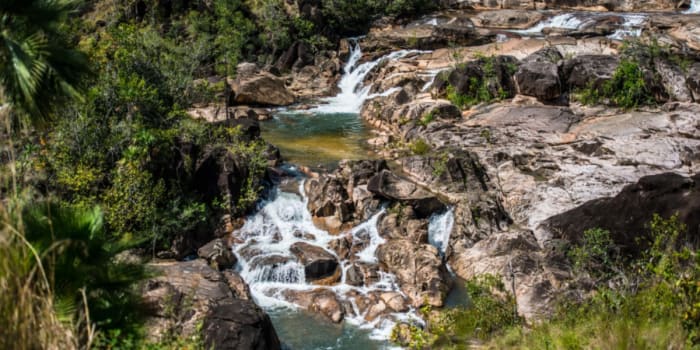
Belize is bio-diverse and budding with extraordinary sights.
What is the weather like year-round in Belize?
One of the nicest things about visiting Belize is the weather. With an average yearly temperature of 84°F (29°C), it’s always warm, yet comfortable. Coastal sea breezes and the jungle and rain forests keep you cool even in the hottest summer months, while winters can be cool but never very cold. Overall, the climate is comfortable year-round. In winter (November to March) the temperature in Belize rarely falls below 60°F (16°C), while the summer (May to September) is around 86°F (30°C). Humidity is fairly consistent at around 85%.
Belize’s dry season is between January and May and has significantly lower rainfall than the rest of the year. When it does rain, it is usually in mild, short bursts. June through December is the wet season, when parts of the country receive up to 150 inches of rain and the heavy, sometimes wild storms associated with the Caribbean occur, usually in the late afternoons. The most frequent rainfall usually happens in June or early July and is punctuated by a break in late July or August, known as the “little dry.”
Statistically Belize does not attract major direct hurricanes, but it does get its share of severe tropical weather with high winds and rain.
When is the best time of year to travel to Belize?
Given the diverse landscapes and topographical differences from north to south, the best time of year to travel to Belize depends on the experience and activities of interest. The dry season, which is between January and May, is the most popular time to visit Belize for its ideal beach weather. During this period, the Cayo District and the Cayes boast clear, sunny days; however, the Toledo District and Placencia enjoy a more tropical climate where there’s a chance of rain at any time of year, but this is what gives these regions their lush and unrivaled beauty!
What is the topography like in Belize?
The coast consists of a coastal plain with mangrove swamps. In the south and interior there are hills and low mountains. Since most of Belize’s land is undeveloped, it is a biodiversity hotspot with many jungles, undisturbed flora and fauna, and the largest cave system in Central America.
What should I pack on a trip to Belize?
If you’re interested, many Belizean hotel properties work with schools and community organizations to promote “Pack for a Purpose” programs to encourage visitors to Belize to pack a separate suitcase with either school supplies, baby products and other products that are a need at the community level.
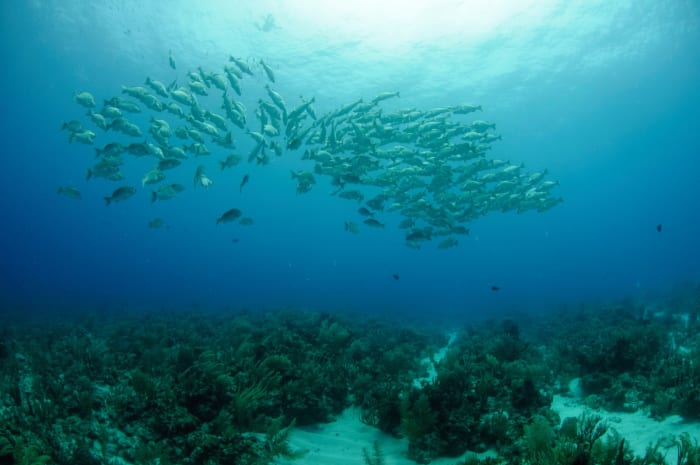
Crystal clear waters are perfect for snorkeling or scuba diving in Belize.
The sun is hot, but the coral reef needs protecting, so be mindful and pack reef-safe sunscreen when traveling to Belize.
Bug spray goes a long way in Belize, especially if you’re looking to venture inland and traverse the jungles, cave systems or treetops (via zip line).
What should I bring home from Belize and why?
Memories! And if you’re looking for something tangible—it all depends on the type of souvenir you’re after—for some it might be an epic scar from snorkeling too close to the coral reef, while for others it might be speciality chocolate truffles or the renowned assortment of hot sauces and even rum.
What animals will I see in Belize?
Belize is laden with remarkable wildlife experiences throughout the country, and the most notable of those experiences includes jaguars (your best chance at seeing a jaguar is on a night walk tour), howler monkeys (you will most certainly hear them before you see them—in many cases they are the alarm clocks no one asked for at many inland resorts), manatees (swim alongside these majestic sea cows in Belize’s South Lagoon or in Caye Caulker), stingrays and nurse sharks (glide with the elusive stingray and nurse sharks in Hol Chan Marine Reserve), whale sharks (these mighty 12-meter long fish can be found in Gladden Spit off Placencia between the months of April to June), and the Belizean national animal—the tapir (also known as the mountain cow). These are just some of the most noteworthy wildlife experiences in Belize—yet 500+ species of birds, including the toucan, raptors and scarlet macaws, can be discovered in the sky and 500+ species of colorful tropical fish can be discovered below the surface, and so many more species roam freely in between.
What are some must-have meals in Belize?
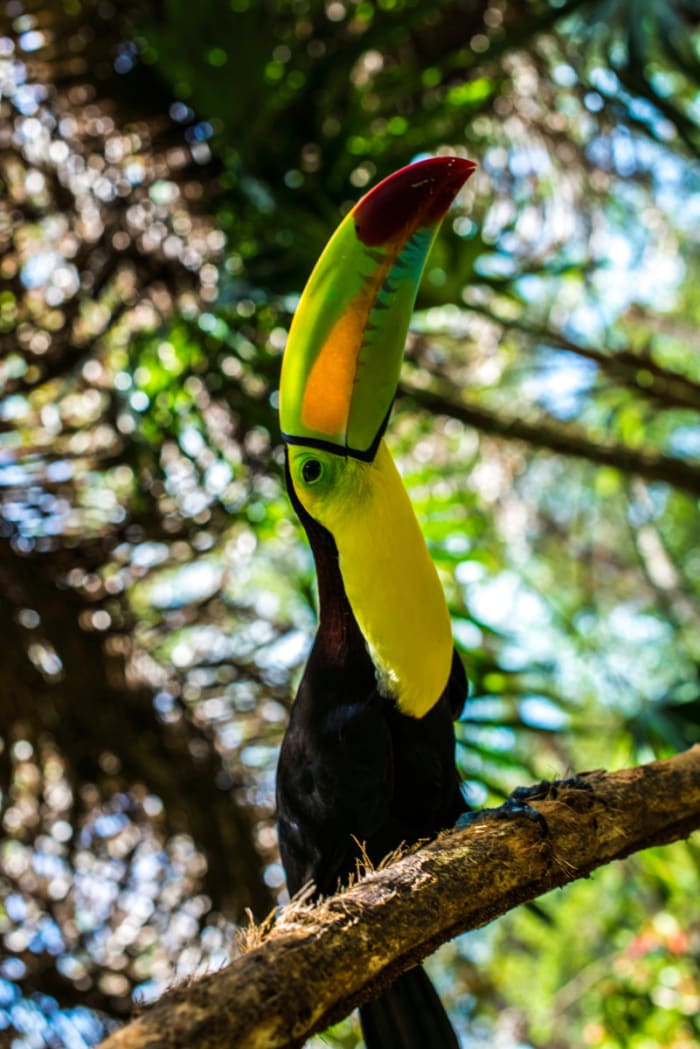
The Toucan is as enigmatic as it is magnificent.
As with the cultural mosaic that permeates throughout the country, Belize’s cuisine is derived from cultural influence! Here are some of the main meals that visitors must try when in each distinct, cultural region:
CENTRAL COAST:
- Meat pies: Belize City is the hot spot for this traditional Belizean dish. Ask the locals and they’ll have a favorite place to get their meat pies and a tried-and-true way to eat it. Meat pies are a delicious combination of onions, peppers, meat and spices inside a warm crust.
- Rice and beans: Typically used to complement a main dish, white rice and red kidney beans are most commonly found in Belize and a specialty in this region. A truly authentic Belizean dinner would pair either of these varieties with stewed or fried chicken.
- Cow foot soup: For a culinary experience not found at home, try cow foot soup in the Central Coast region. The cow foot is boiled to soften and mixed with a variety of vegetables, coco seasoning and okro pepper.
- Stewed chicken: One of the most traditional Belizean dishes, stewed chicken is one that every visitor should experience. The secret to this delectable dish is to brown the chicken that’s been rubbed with an annatto paste called recado, and sprinkled with salt, pepper and garlic before adding water, a dash of vinegar, chopped onions and sweet peppers.
NORTHERN BELIZE:
- Escabeche: This dish expertly blends flavors from Mestizo, Spanish and Maya cultures with a spicy combination of chicken smothered with onions in vinegar, peppers and other spices. Fresh corn tortillas are made to complement the dish, which are prepared by mixing ground whole corn with white lime and water.
- Chimole soup: Chimole, also known as “Black Dinner” is a tasty, black-colored soup with roots in Mayan and Mestizo cultures but enjoyed by all in Belize. This savory hearty soup made with the unique ingredient black recado is a local favorite.
SOUTHERN BELIZE:
- Cohune cabbage: Cohune cabbage, made with hearts of palm flavored with yellow ginger (turmeric), is one not to be missed! This curried cabbage is at its best in the Southern towns of Belize.
NORTH ISLANDS:
- Seafood: Due to Belize’s excellent geographical location, the seafood is plentiful, of high quality and available almost anywhere in the country, but is at its freshest on the islands. Conch, shrimp, squid, crab soup, ceviche are just a few of the seafood selections found on Belizean menus.
- Lobster: At the close of lobster season, which runs from February through July, several coastal towns including San Pedro on Ambergris Caye, Caye Caulker and Placencia host the world-renowned lobster fests. This celebration features live music and dancing along with the delicious catch of the season. The lobster fest is scheduled every year in June and attracts visitors from all over the globe to enjoy the wide array of lobster delicacies.
BELIZEAN BRANDS:
- Marie Sharp’s Hot Sauce: No dining table in the country is complete without a bottle of Marie Sharp’s Hot Sauce. An extremely distinctive element of Belizean dining, the original Marie Sharp’s sauce is made from a base of habanero peppers, carrots and onions. The brand now offers the pepper sauce in varying degrees of heat, from “mild” to “beware,” as well as jams and chutneys to go with any food or dish.
What are some must-have drinks in Belize and why?
In Belize, no meal is truly complete unless it’s accompanied by the country’s national beer—an ice-cold Belikin. Produced by the Belize Brewing Company, this beer comes in varieties of stout, lager and premium. The original beer recipes came from the founding brew masters who all came to Belize from Germany. Since then, the beer has varied ever so slightly to give it a distinctly Belizean taste.
The liquor of choice in Belize is rum. Five-year-aged Prestige Rum is considered the best of the Belizean rums; other local favorites include Travellers Rum, One Barrel and Caribbean Gold Rum.
What are the top-five must-see places in Belize?
- San Pedro
- Caye Caulker
- San Ignacio
- Hopkins
- Placencia
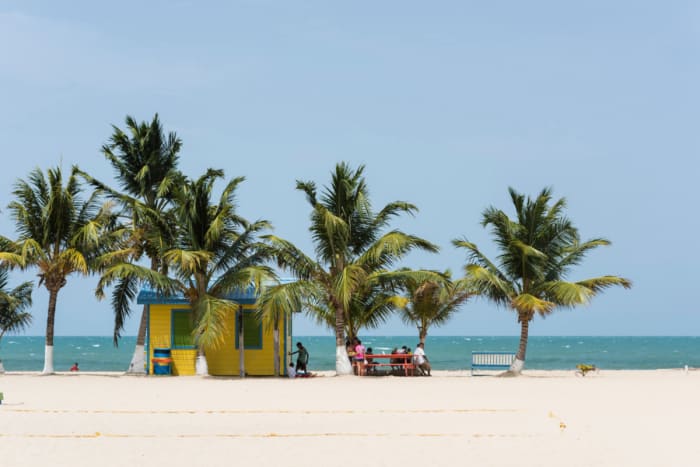
Placencia, Belize.
What are the top-five experiences in Belize?
- Experience Xunantunich
- Snorkeling or diving in Hol Chan Marine Reserve
- Actun Tunichil Muknal (ATM) Cave experience
- Blue Hole Flyover
- Birding (just about anywhere in Belize!)
For an adventure-backpacker-outdoorsy type of traveler, what can I experience in Belize?
- Spend the morning zip lining and afternoon cave tubing
- Waterfall in Mayflower Bocawina National Park
- Swim with the sharks (and loggerhead sea turtles, eagle rays, more than 500+ species of tropical fish) in Shark Ray Alley
If I am looking for some rest and relaxation, what can I experience in Belize?
- Visit Caye Caulker and take the local motto “go slow” to heart.
- Belize is home to more than 500 species of birds and most of them can be seen without having to venture deep into the jungle, making bird watching a perfectly serene and leisurely activity to enjoy on an R&R vacation.
- Wherever you decide to stay in Belize, whether it’s by the beach or inland, you are sure to wake up to a relaxing experience. While staying along the coast or on one of the many islands, wake up to the sounds of the gentle waves of the Caribbean Sea and enjoy the calls of pelicans catching their early morning meals.
- While enjoying your jungle adventures, cool nights in the mountains give a cozy feel, while the sounds of birds and even monkeys serve as your natural alarm clock to get your morning started. Many resorts countrywide offer spa treatments, some very unique, as well as invigorating experiences such as treks to stunning waterfalls and pools, and yoga sessions beachside, near waterfalls or even on Maya temples.
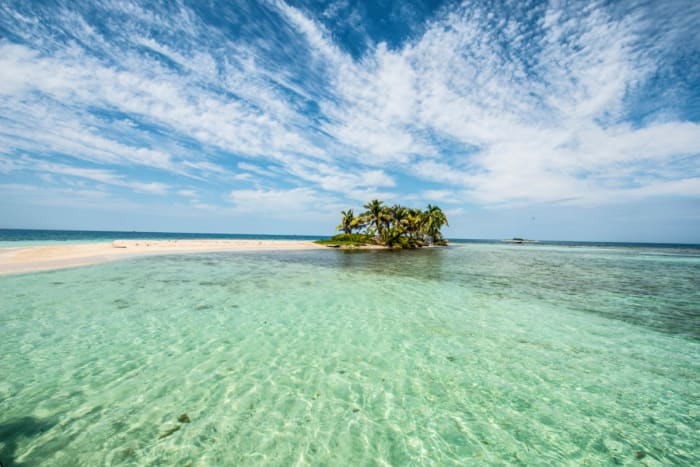
Water that sparkles from afar.
Budget traveler tips for traveling to Belize?
Belize currency exchange is extremely easy for U.S. visitors. The Belize dollar is locked at $2 Belize = $1 USD, making it easy to manage a budget while in Belize.
Similar to the country’s diverse range of cultures and topography, the country also boasts a diverse range of accommodation offerings that cater to different budgets—from luxurious villas to charming guesthouses.
What’s more is that Belize’s greatest asset—its natural wonder—is often free to explore, or requires a meager park entrance fee. Mountain Pine Ridge, for example, is where visitors can explore caves, rivers and ruins all within the Cayo District in Western Belize.
Caye Caulker is a budget-friendly island in the north, and it is beloved by travelers of all budget sizes. Iconic Belizean experiences, such as snorkeling, diving, fishing and kayaking are all accessible given the proximity of the Belize Barrier Reef.
What is the one photo I must take while in Belize?
If you’re in Belize, the one must-take photo depends on where you are! If you’re in the North Islands, you would be remiss not to experience and capture the famed Great Blue Hole. If you are inland in the Cayo District, however, you simply must experience and capture the majestic Xunantunich or Lamanai Maya sites. And no matter where you are in Belize, if you’re able—catching a photo of the magnificent and elusive toucan would be a cherishable souvenir!
What are people most surprised about when visiting?
Belize is the only English-language-speaking country in Central America. While English is the official language of Belize, Kriol is the local dialect most commonly spoken. Also, Belize has the lowest population density in Central America with 35 people per square mile or 14 people per square kilometer.
Belize is a cultural mosaic, a sincere melting pot of colorful personalities, making Belize’s 321,115 residents the country’s greatest resource for tourism. Belizeans are made up of Maya, Mestizo, Kriol, Garifuna, East Indian, Mennonite, Arab and Chinese people.
From the wildlife perspective, Belize is home to the only jaguar reserve in the world, the Cockscomb Basin Wildlife Sanctuary!
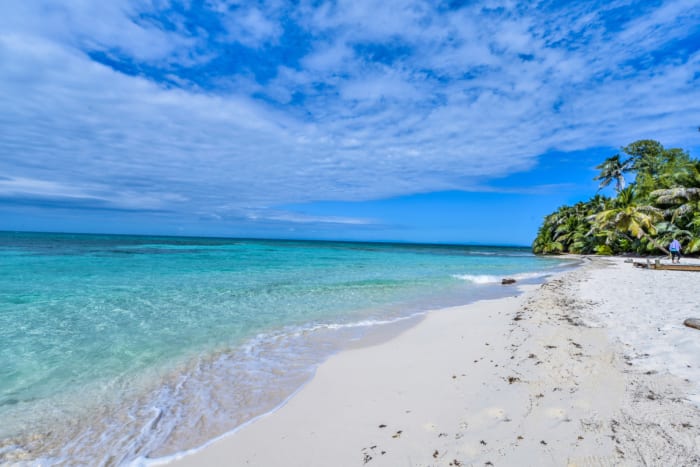
The beach awaits your footprints.
Belize Tourism Board
